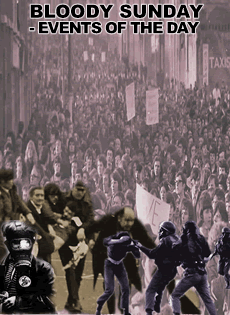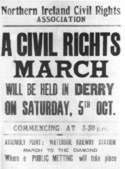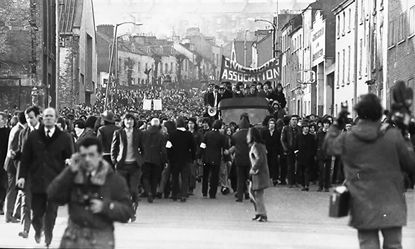


| "London"-Derry | ||
 |
Bloody
Sunday
|
 |
Derry monastic era medieval period colonial times cultural general 20th Century Bloody Sunday
|
The Guardian 2005 "Today, almost 33 years after the event, counsel for the public inquiry headed by Lord Saville of Newdigate, summed up all the evidence it has heard. The inquiry, which is expected to cost £155m, has been the biggest investigation in British legal history." http://www.guardian.co.uk/bloodysunday/article/0,2763,1357102,00.html "Sorry" will never be enough Was the march illegal - YES Did they have the right to march anyway - ? Should the army have acted as they did - NO Were the shootings premeditated or accidental - ? “Let me make it clear that the aim of the inquiry is not to accuse individuals or institutions, or to invite fresh recriminations, but to establish the truth about what happened on that day, so far as that can be achieved at 26 years' distance.... Our concern now is simply to establish the truth and to close this painful chapter once and for all.” Tony Blair If Blair did not want to appropriate blame but simply to "close a painful chapter" then am I alone in wondering why that £155 million pounds wasn't simply paid out in compensation and investment in the renewal of Londonderry? Interactive account of the route of the march http://www.guardian.co.uk/bloodysunday/flash/0,6189,184944,00.html Angelique
Chrisafis Tuesday November
23, 2004 The
Guardian He said the tribunal had to decide whether "the situation the soldiers faced was radically different to that of which the civilian evidence speaks." But he resisted claims by lawyers acting for the families of victims that a "shoot-to-kill" policy was in operation. Mr Clarke has presented his final submission, consisting of 10 volumes, to the inquiry team. His closing speech is expected to end today, and the tribunal's report is expected next summer, more than seven years after Tony Blair announced the inquiry, which will have cost more than £150m by the time it ends. http://www.guardian.co.uk/bloodysunday/article/0,2763,1357546,00.html The public inquiry into the events of Bloody Sunday was announced by the British prime minister, Tony Blair, in January 1998. He was responding to the persistent demands of Northern Ireland's nationalist community and the Irish government. The inquiry convened in Derry on March 27 2000. Lord Saville's opening speech lasted a record 42 days and there have been 432 days of oral testimony. Lord Saville and his co-judges have amassed at least 60,000 pages of written submissions. Nine hundred and twenty witnesses have given oral evidence, and there have been some 1,000 written statements from civilians, soldiers, police officers, journalists, government officials and paramilitaries. There were vexed legal arguments about the identification of military witnesses. Lord Saville wanted the former soldiers involved in the shootings to be named, but the House of Lords ruled that they were entitled to the protection of anonymity. Where was
the inquiry heard? The inquiry moved to London temporarily to hear the evidence of paratroopers who had objected to giving evidence in Derry, citing fears for their safety. What were
the most notable moments of the inquiry? He bitterly denied allegations that he had fired the first shot and called claims he fired on soldiers "lunatic". Six IRA men dismissed claims Mr McGuinness had planned to use a nail bomb that day. Paramilitaries had at first refused to cooperate with Lord Saville but many came forward and gave evidence anonymously after the tribunal ruled that MI5 and army intelligence could release records identifying members of the Provisional and Official IRA. Sir Edward Heath, prime minister in 1972, angrily rejected claims that he was more interested in Europe than in murders in Northern Ireland. It was the first time a former PM had given evidence to an inquiry. Some soldiers admitted that they had lied to the military police in their original interviews in the wake of the killings. One paratrooper said that he could not justify a "single shot" fired by the soldiers that day. The officer leading the troops denied they were "thugs". Did any
genuinely new evidence come to light, so long after the event? Statements by the soldiers to the military police, which had been released to Widgery but not the families of the victims, were also made public at the Saville inquiry for the first time. The statements from some paramilitaries were also unprecedented. However, given the huge cost of the inquiry, Lord Saville is under pressure to show that the endeavour was worth it. Its supporters argue its value lies in "truth and reconciliation". What did
Lord Widgery say? What was
Widgery's judgement on the soldiers involved? Were the
Bloody Sunday weapons used still available for examination? · Derek Brown was the Guardian's correspondent in Northern Ireland from 1971 to 1977
Special reports Inquiry into "Bloody Sunday" opens in Northern Ireland By Mike Ingram 7 April 2000http://www.wsws.org/articles/2000/apr2000/ire-a07.shtml What has gone down in history as “Bloody Sunday” is a key event in the 30-year history of the so-called “Troubles”. Just three years after the Labour government had sent the British army to Northern Ireland in 1969, the shootings blew apart claims that the military were in the province to defend the Catholic minority. In the late 1960s and early 1970s, pro-British Loyalist paramilitaries began a campaign of sectarian assassinations of Catholics living in the six counties. This came amidst mounting social and political unrest expressed in the development of the mass civil rights movement protesting anti-Catholic discrimination. These attacks, combined with increased harassment from the largely Protestant Royal Ulster Constabulary and the British Army, contributed to the growth of Irish nationalist movements such as the Irish Republican Army (IRA). In August 1971 the Northern Ireland government had introduced legislation under the Special Powers Act, which provided for internment without trial. Mass arrests began and by mid-January 1972 there were over 600 internees. These were the circumstances in which 10,000 people gathered for a march on January 30 1972, organised by the Northern Ireland Civil Rights Association (NICRA), despite its having been banned by the government. In order to secure the support of Sinn Fein for the May 1998 Good Friday Agreement, aimed at ending paramilitary conflict in Northern Ireland, the British government was obliged to accede to the demand for a fresh inquiry into Bloody Sunday. In January, therefore, on the eve of the twenty-sixth anniversary of the killings, Prime Minister Tony Blair announced an independent judicial inquiry, to be headed by the British Law Lord, Lord Saville of Newdigate, and two judges from Commonwealth countries. The Saville inquiry has interviewed more than 600 soldiers including senior military staff, 729 civilians, 30 journalists and photographers, 20 government officials/politicians and 53 RUC police officers. The proceedings could last up to two years. In announcing the inquiry, Blair made clear that its purpose was not to identify, much less prosecute, those responsible for the killings. “Let me make it clear that the aim of the inquiry is not to accuse individuals or institutions, or to invite fresh recriminations, but to establish the truth about what happened on that day, so far as that can be achieved at 26 years' distance.... Our concern now is simply to establish the truth and to close this painful chapter once and for all.” In July 1999, the High Court rejected an appeal by the inquiry tribunal that the identities of 17 paratroopers who fired their guns on the day of Bloody Sunday should be revealed. Hundreds more soldiers were granted the same anonymity in October 1999. Despite these limitations the material being presented to the inquiry has already provided a damning indictment of Britain's role in Northern Ireland. Last September, the forensic scientist who carried out the original tests said to have shown that some of the demonstrators shot by British soldiers had handled firearms said he was wrong. John Martin acknowledged that the lead deposits found on several of the victims' hands could have come from other sources—including emissions from car exhausts. Thus began the unravelling of the official whitewash of Bloody Sunday presented in an April 1972 inquiry by Lord Widgery. According to that version, the soldiers had shot in self-defence, having been fired on first. Widgery also said there would have been no deaths if there had not been an “illegal march” which had created “a highly dangerous situation”. As the date for the new Saville inquiry drew closer, a concerted effort was been made to conceal what really took place in Derry in 1972. In February, the Ministry of Defence (MoD) admitted that a month earlier it had destroyed two of the five remaining rifles used by the British army on Bloody Sunday. Of the 29 rifles that may have been fired on that day, 14 have been destroyed by the MoD. A further 10 were sold to private companies. The inquiry's first day on March 27 revealed secret documents indicating that the Army had “suggested” an operation in the Bogside area of Derry prior to the 1972 killings. The Saville inquiry heard that a top-secret communication from the head of the army, General Michael Carver, to then Conservative Prime Minister Edward Heath suggested it might be necessary to go into the predominantly Catholic Bogside district to “root out the terrorists and hooligans”. The Carver document was made public during the opening submission by inquiry counsel, Christopher Clarke QC. It was drawn up in October 1971, three months prior to Bloody Sunday. It noted, “The timing, political implications and local reaction to such an operation would have to be carefully judged.” The document also presented three options for policing Derry that indicate political concerns at the time. The first option was to maintain the status quo, in the hope that political progress would be made and a return to normalcy effected. The second was to demonstrate the ability to go into the area at will, establishing regular patrol patterns. The third option was to occupy and dominate the area and, together with the RUC, forcibly remove barricades erected by Catholics to protect their communities. Documents presented on the second day of the Saville Inquiry show that the events of 1972 were not a response to a “terrorist threat” but a show of strength designed to intimidate the Catholic population in general, and those opposed to British rule in particular. Continuing his opening submission, Clarke referred to the minutes of a meeting between Heath and the then Northern Ireland Prime Minister Brian Faulkner. He quoted Heath saying that Westminster could no longer risk giving the impression of “being borne along by events ... “The situation was now grave, socially, economically, and politically and the British public was losing patience. The government at Westminster could not continue to support Stormont [the Northern Ireland parliament] unless public opinion was behind it,” the notes said. Clarke referred to a document explaining how, in early December 1971, security operations were carried out in the Bogside and Creggan (another largely Catholic area) in Derry. On December 14, 1971, a British Cabinet committee on Northern Ireland heard an outline of the security situation. General Sir Robert Ford, Commander of Land Forces in Northern Ireland at the time, told the committee that efforts by political moderates in Derry had failed. Security forces were facing an “entirely hostile Catholic community,” numbering 33,000. Clarke went on to describe what amounts to a deliberate policy of provocation on the part of the British army. This was so extreme it was even opposed by the then Derry Chief Constable, RUC Chief Superintendent Frank Lagan, who argued that the scheduled march against internment organised by NICRA should be allowed to proceed along the scheduled route to a rally at Guildhall. Clarke told the hearing: “It appears to be that Mr. Lagan thought that if the march was stopped, sporadic outbreaks of marching might occur over the course of the next few days throughout the city but that if it was allowed to go to the Guildhall they would go through and make their point.” In a letter to General Ford, Brigadier Andrew Patrick MacLellan, in charge of the army in Derry, said that Lagan's proposal resulted from the fact that his sympathies lay “entirely with the Catholic community”. The then RUC Chief Constable, Sir Graham Shillington, rejected Lagan's appeal and said he wanted the march stopped. The inquiry was told of a meeting between senior military officers two days before Bloody Sunday, which predicted the type of conflict that was to take place. An unnamed Colonel said the only additional measure left would be the use of firearms. If that were to happen it would not be gunmen who were killed, but innocent members of the public. He said this was a harsh and final step, equivalent to declaring that all else had failed. The Colonel said it must be rejected except in extreme circumstances, but it could not be ruled out. General Ford was reported to have said in 1972, “I am coming to the conclusion that the minimum force necessary to achieve a restoration of law and order is to shoot selected ring leaders amongst the Derry young hooligans after clear warnings have been issued.” The British attitude to the civil rights march was also expressed in a memo to the commander of 8 Brigade telling them to “prepare a plan over this weekend”. The Brigadier should take into account “the likelihood of some sort of battle, and therefore he must choose a place of tactical advantage,” the memo said. In a more recent statement to the tribunal, General Ford, now Lord Ford, said the situation with the “Derry young hooligans” had reached such an impasse he felt he had to try something new. “The suggestion to shoot a few leaders was not a suggestion to kill them,” he said. ( PARDON ? - SHOOT WITHOUT INTENDING TO KILL ? ) How this policy worked out in practice was revealed in Clarke's comments regarding a tape of army radio transmissions recorded by a civilian, Mr. Porter, two days before the civil rights march on January 28, 1972. The tape records an incident in William Street, in which a soldier claims he can see a “nail bomber”, but who does not appear to have anything in his hand. The soldier asks his commanding officer if he should shoot him. The superior asks: “Are you absolutely certain he's the nail bomber?” When the soldier replies that he is, the officer says: “Shoot him dead.” There is a pause while several shots are fired. Following this the soldier reports back that he “missed him by about two inches”. The officer replies: “Bad shooting.” The revelations so far are only the tip of the iceberg. Clarke's opening submission alone, presenting the evidence uncovered by the two-year investigation, is set to last four weeks. See Also: Bloody Sunday Inquiry hears evidence suggesting deliberate "shoot-to-kill" policy by British Army http://www.wsws.org/articles/2000/apr2000/ire-a20.shtml http://www.bloodysundaytrust.org/eduevents.htm http://cain.ulst.ac.uk/events/bsunday/mad.htm
‘The only additional measure left is the use of firearms - and innocent civilians would be more likely to be killed than any gunmen’ British Army intelligence assessment, Thursday 21 January 1972. Vital evidence was gathered at the time by Peter Pringle and Philip Jacobson who were members of the Sunday Times Insight team. full - http://cain.ulst.ac.uk/events/bsunday/pringle00.htm THE BLOODY Sunday tribunal is raising more ghosts than it lays to rest, which isn’t what Tony Blair intended when he announced the inquiry in January 1998. http://www.marxists.de/ireland/mccann/sw175712.htm Mr McGuinness, who has admitted being second in command of the Derry IRA at the time of Bloody Sunday in 1972, said in an interview on BBC Radio Foyle yesterday that he was no longer a member of the Provisionals. Mr Robinson insisted the Mid-Ulster MP was still a member of the seven strong IRA army council, and had been responsible for hundreds of murders as chief of staff from 1978-82. http://www.victims.org.uk/25-06-01a.html Even before the dead were buried, the British propaganda machine went into action to justify the slaughter. The dead and wounded were branded as armed terrorists, the soldiers were said to have come under heavy fire. The Queen decorated and praised the "heroic" killers. http://www.seeingred.com/Copy/1.1_bloody.html http://www.vincentpeters.nl/triskelle/history/bloodysunday.php?index=060.170.040.020 The British government has two closely related probems in dealing with Bloody Sunday. The first has to do with political motivation and the responsibility for the massacre, the second with the possibility that a subsequent cover up was organised at the highest level within the British political and legal establishment. http://pubs.socialistreviewindex.org.uk/sr216/mccann.htm
more pictures http://home.comcast.net/~hories/Ireland/Derry/Derry.html |